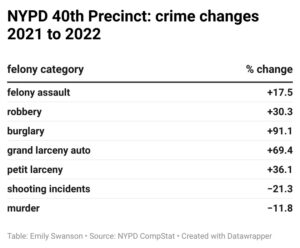Residents of Mott Haven, Melrose and Port Morris are being hit with double-digit increases in robbery, burglary, carjacking and other crimes. Although shooting incidents and murders are down for the year, the Dec. 12 shooting of four near the Mott Haven Houses has residents on edge.
Residents and local leaders are asking for more responsive neighborhood policing, more urgency from elected officials, and a compassionate but effective means of removing people from the streets. Worried about their safety, some have made drastic changes to their daily routines.
Jordan Green and Adriana Garcia run a design business from a studio at 136th Street and Willow Avenue in Port Morris, and live nearby.
Green said they see many people who appear to be mentally ill and people sleeping in cars, and he believes that “Not a lot of police are gonna bother you” on the streets of Port Morris.
The couple is empathetic but wary of those they see. On weekends, when the studio building is mostly empty, Green carries a stick or cane if he has to come late at night.
For the couple, feeling unsafe is expensive. They don’t feel safe using public transportation and feel the financial toll of daily Uber rides to work is worth it. Even simple walks are worrying now. Green and Garcia used to take their dog, Solange, on long walks around 5 or 6 a.m., but now they won’t go unless the sun is out.
Garcia is a proud Bronx native, but she doesn’t take her safety for granted, particularly when out alone: “I have pepper spray and I get it ready. I unlock it. I have it ready in case anyone comes to me, because the minute it gets dark around here, I don’t feel comfortable walking by myself.”
Although Green and Garcia have not been the victims of violent crime in Port Morris, they’ve had some unsettling incidents: Green’s catalytic converter was stolen, and his young daughter was closely followed by someone in a car.
“You call the police and they don’t come,” Garcia said. “What’s the point? Are we all just going to get guns and start shooting each other?”
The couple believes in the power of community policing but doesn’t see it in action. Without consistent police presence, Garcia sees “citizens trying to argue and fight with each other instead of it being, hey, let’s work together to build a better future.”
As a newcomer to the neighborhood, Green became involved with the community board in hopes of working on solutions: “As the community, we have to pull together and make it safe for ourselves. Whether it’s a community watch, cleaning up our own streets or policing ourselves, that’s going to be the easiest way.”
“IT’S DEFINITELY SCARY”
Pamela Yates, 29, works at the Bronx Vision Center, nestled between a Mexican restaurant and a charter school on 138th near Willis Avenue. The shop carries designer eyeglasses from luxury brands such as Prada and Cartier.
Yates said the door never used to be locked during business hours, but a buzzer was installed a few months ago in response to robberies of nearby businesses. The recent spike in crime has “definitely changed the way we’re interacting with everybody. Here it’s all females, so it’s scarier for sure,” she said.
Robberies nearby have shaken the Bronx Vision Center staff: “We’ve had the business down the street, the bakery got robbed a couple of weeks ago. We also had the smoke shop get robbed a couple weeks ago.”
Yates added, “We think they are targeting retail business a little bit more. We do sell high-end merchandise, so that definitely makes us a target.”
In her life outside of work, Yates has stopped wearing headphones while walking, has started carrying pepper spray, and is generally much more alert. “It’s definitely scary,” Yates said. “We’re trying to deal with it.”
“NOT AS BAD AS IT USED TO BE”
Bee’s Famous Haircuts on 138th and Cypress has been a neighborhood gathering place for 50 years. People come by for cuts and shaves as well as stories and advice from the owner Brian (“Bee”) McFadden, who sees himself as something of a therapist for his many customers. At his shop, McFadden said that crime is a constant topic of discussion.
Stanley Greene, 65, is a regular customer of Bee’s and lives in the nearby Mill Brook Houses on 135th and St. Ann’s Avenue.
Sitting in McFadden’s chair, Greene recalled the days when community policing was the norm. As he described it, officers were consistently inside NYCHA buildings and on the corners. He saw plenty in his work as a NYCHA caretaker.
But today, Greene said, “I think the police have to be more interactive with the community as a whole. I don’t see that here. I don’t want to say they don’t care, but I don’t see enough police presence.”
McFadden, who is in his mid-50s, agreed that police presence used to be much better in decades past. “People knew this officer would be at a certain place or on a certain beat, and I believe that that is a deterrent,” he said. This presence also naturally resulted in more positive relationships: “Knowing the officer personally had a lot to do with people feeling like, okay, I am protected. I have someone looking out for me.”
Greene and McFadden have been around long enough to remember when crime in the South Bronx was much worse. According to NYPD data, all seven categories of major crime have drastically decreased when compared to the 29-year picture. For instance, robberies and burglaries are 60-80% lower now, and murders are down 77%.
“It’s bad, but it’s not as bad as it used to be,” Greene said.
Greene and McFadden both say they haven’t changed much of their daily routines because they’ve lived by certain rules all along.
The first step, Greene said, is to pray before leaving home. On the train or bus, he’s on high alert: “I ain’t picking up no phone. I’m watching. I ain’t reading no newspaper or doing anything on the phone. You gotta be aware.”
Greene actually makes a point to talk to strangers and feel them out. “You can sense when somebody’s bad,” he said. And if he encounters someone threatening, “It’s me or him, and it ain’t gonna be me.”
Greene retired from NYCHA in August, but he said that throughout his decades of work, regardless of location, he chose between several different routes home. He used different combinations of buses and trains because, he said, “People see patterns,” and he always tried to avoid being too predictable.
COMMUNITY BOARD 1 HEARS FRUSTRATIONS
Arline Parks, chairwoman of Bronx Community Board 1 in the 40th police precinct, said at the November meeting that crime and quality of life problems have risen to a level “like never before.”
At the October meeting, where crime concerns dominated discussion, the board asked the NYPD to attend all future meetings to provide updates and answer questions. Two officers agreed to this, yet no one showed up to the November meeting. Board members were beyond frustrated.
Without the NYPD present to hear it, board members aired concerns amongst themselves. One board member, Mora Cosme, complained about police response times, saying she witnessed someone breaking into a neighbor’s car, called the police around 7:30 a.m., and didn’t receive a call back until around 11:30 am. She said the officers told her they were “too busy to respond to something like that.”
“It can seem like nothing major to them,” she said. “But to us, it’s a really serious quality of life issue that escalates to something else. Especially in our district.”

Parks said the board is “in constant contact” with the NYPD but has been told that “they are short-staffed and trying to cope with it as best they can,” which she acknowledged is no consolation to worried residents. Parks said she has already gone above the precinct level to the deputy mayor’s office, and still, “It’s falling on deaf ears.”
Parks drew a connection to low voter turnout: “The community [is] not voting as a bloc” and when they do vote, they’re “voting for the same people who got us here.”
Board member Lola Dupuy, 35, reiterated this frustration: “It gets to allocation of resources, and why are you okay with this neighborhood getting too few resources? That’s a decision that someone is making- where to put the resources, where to put the priorities. And this district is not the priority.”
Dupuy has run out of patience with police and elected officials. “We know what the issues are,” she said. “I feel tired of having the same response to the same problem.”
“It’s their job to know what the problems are and to be advocating for those things,” she said. “We just have to be really loud if we want anything to be done about it.”

